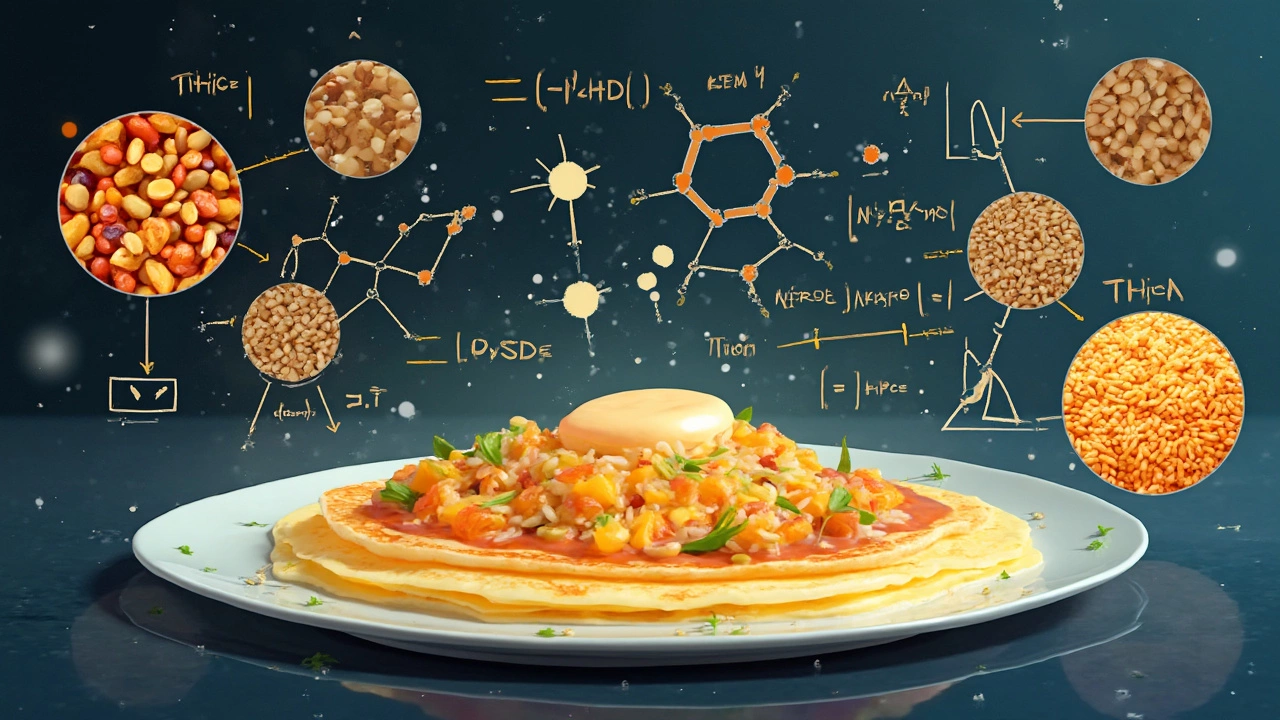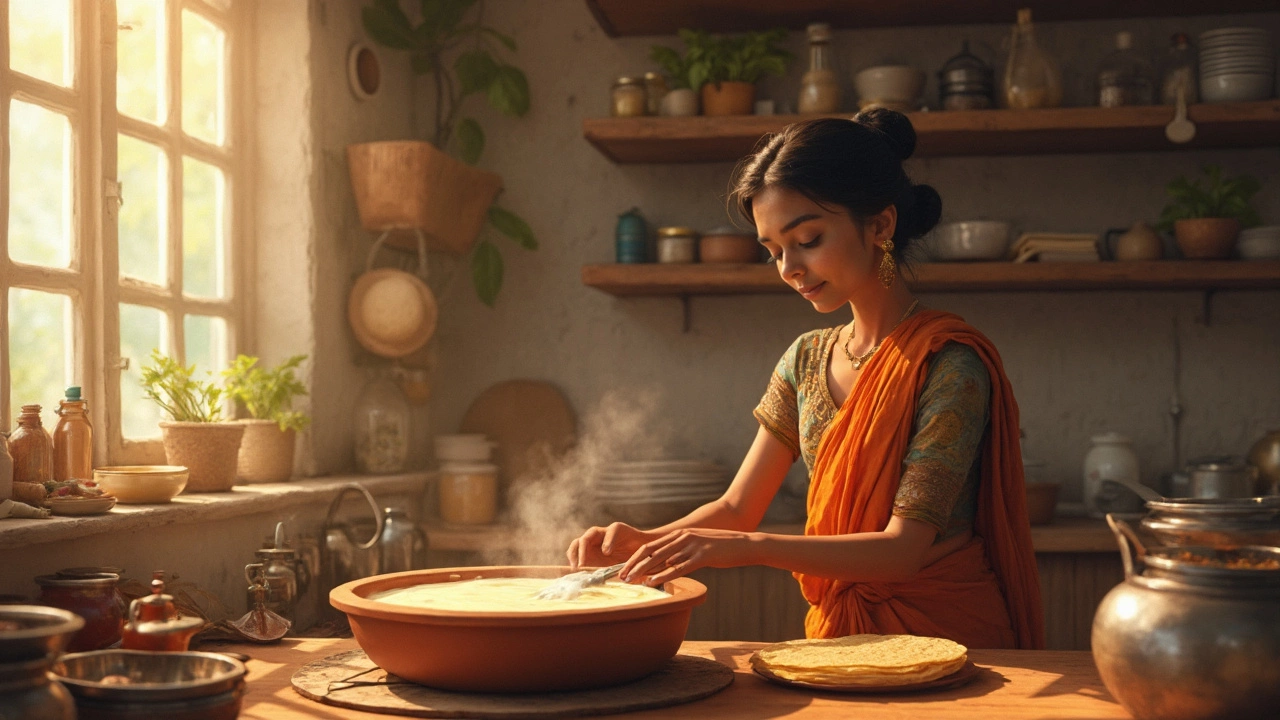15 Mar 2025
- 0 Comments
So you're making dosas from scratch. It's that magical moment mixing rice and urad dal into a batter with so much potential. But then comes the great mystery: should your dosa batter be thick or thin? Surprisingly, it's not a straightforward answer. It depends on what you're aiming for.
If you want crispy dosas, aim for a batter that's kind of like pancake batter but a touch more runny. Pour it on a hot griddle and spread it thin, like a flat crepe. This is your ticket to that crisp and satisfying texture many crave. Too thick, and you might end up with dosas that are more like pancakes—which is fine, but maybe not what you're after.
- The Basics of Dosa Batter
- Why Consistency Matters
- Adjusting Batter Thickness
- Troubleshooting Common Issues
- Tips for Perfect Dosas
The Basics of Dosa Batter
Before diving into whether your dosa batter should be thick or thin, it's good to understand what goes into making it. At its heart, dosa batter is a simple mix of rice and urad dal (that's split black gram). These are the stars that give your dosa its taste and texture.
Getting Started
You'll want to start by soaking the rice and urad dal separately for about 4 to 6 hours. Why separate? Well, each ingredient needs its own time to soften up. Once soaked, you'll blend them together until you have a smooth consistency. But don't rush it—blending is key to a good batter.The Role of Fermentation
After blending, let your batter sit in a warm place for fermentation. This usually takes about 8 to 12 hours, depending on the temperature in your kitchen. You'll know it's ready when it doubles in size and has a slightly sour aroma. Fermentation is magic—it makes your dosa crisp and gives it that trademark tangy flavor.And here's a fun fact: Fermentation boosts the nutritional value. It increases the bioavailability of nutrients, which is just a fancy way to say your body can use them better.
Basic Proportions
Traditionally, the ratio is about 3 parts rice to 1 part urad dal. Some folks like to add a bit of fenugreek seeds for extra flavor and better fermentation. It's not mandatory but can give your dosa a little something extra.So that's the basic blueprint. Once you have this down, you can start experimenting with thickness to get the end result that's just right for you. Remember, practice makes perfect!
Why Consistency Matters
Consistency is the key player in your dosa batter quest. It determines not just the texture, but also how the dosa cooks and tastes. Ever wondered why some dosas are delightfully crispy while others feel like pancakes? It all comes down to getting that consistency just right.
The Science Behind It
The thickness of your dosa batter affects heat distribution. A thinner batter spreads quickly and evenly, allowing for rapid moisture loss and creating that crispy finish. Thicker batters, on the other hand, hold more moisture and heat takes longer to reach the center, sometimes resulting in a chewy dosa.
How to Test Your Batter
Not sure if your batter is the right consistency? Here's a quick test:
- Dip a spoon in the batter. It should coat the back of the spoon thinly without dripping right off.
- Pour a ladleful onto a heated pan. You should be able to spread it in a circular motion easily. If it's too thick, it won't spread as well.
Remember, personal preference plays a role too. Some like their dosas thick and chewy, some thin and crispy. Find what you and your family enjoy the most!
Learning Curve
Creating the perfect dosa is an art that might take time to master. Don't get discouraged if your first few attempts aren't exactly what you imagined. Adjust your batter next time based on what you observe as you cook. Soon, you'll develop a feel for whether your dosa batter is thick or thin enough, almost without thinking.

Adjusting Batter Thickness
Adjusting the thickness of your dosa batter is where the magic happens. Too thick, and you'll have a hard time spreading it thinly on the griddle. Too thin, and, well, it might stick all over and become a mess. Let's dive into how you can get that just-right consistency.
Why Consistency Matters
The right batter consistency is crucial. If your batter is too thick, it won’t spread well, resulting in soft dosas. However, if it's runny, it might become hard to control, making them uneven. Getting the balance just right can transform your dosas.
Tip 1: Know Your Flour
Everything starts with understanding your ingredients. How much water your rice and urad dal have absorbed during the soaking phase can determine how much additional water they need later. Always start by following a basic recipe, like a 3:1 ratio of rice to urad dal, and then adjust.
Tip 2: Add Water Gradually
While blending, add water slowly. It’s easier to add more water than to fix an overly thin batter. As you blend, aim for a smooth yet slightly grainy texture.
Tip 3: The Test Pour
Once blended, try ladling out a small amount of batter onto a flat surface. The batter should flow smoothly but not run off the edges too rapidly. If it does, it's too thin. If it sits stiffly, it needs more water. Adjust with water a couple of tablespoons at a time.
"A good dosa batter should be like pancake batter, but slightly runnier and very smooth." - Chef Asha Gomez
Tip 4: The Fermentation Effect
Remember that the consistency changes post-fermentation—it usually thickens. Some folks thin down the batter again before use. Hence, after fermenting, assess the texture once more before cooking.
Tip 5: Split Testing
If you're experimenting, divide your batter into smaller batches. Adjust one batch to be slightly thicker than the other. Cook them to see which one yields your preferred dosa. This comparison is a game-changer for precision.
Measuring the Ideal Thickness
For the science-minded, here's a fun exercise. Measure the spreadability: A good dosa batter will evenly spread to about 8 inches in diameter when you pour a ladle applied with gentle swirling motion.
Troubleshooting Common Issues
Alright, let's address the inevitable bumps in the road. Making dosa batter isn't always smooth sailing, but don't worry, we've got some tips to tackle common problems.
Too Thick Batter
If your batter turns out too thick, don't fret. Simply add a bit of water until it reaches the right consistency, like a slightly runny pancake batter. Stir well to ensure it’s evenly mixed. Overly thick batter can make dosas cook unevenly, leading to a heavy texture.
Too Runny Batter
On the flip side, if it's too runny, it might not hold shape on the griddle. A quick fix is to add a bit of rice flour or semolina. This helps thicken it up without compromising texture.
Batter Not Fermenting
Struggling with fermentation? It’s crucial for that classic tang and texture. If your batter isn't fermenting, check the temperature. Room temperature is key, around 30°C (86°F). In cooler climates, try placing it in a warm oven with the light on.
| Optimal Temperature Range | Fermentation Time |
|---|---|
| 20-25°C (68-77°F) | 12-16 hours |
| 30-35°C (86-95°F) | 6-8 hours |
Sticky or Greasy Dosas
If your dosas are sticking to the tawa or getting greasy, it might be the pan. Ensure it’s the right temperature before you pour the batter. Use a nonstick or a well-seasoned cast iron skillet for best results. A little oil helps, but too much can make it greasy.
Remember, practice makes perfect. Adjust, tweak, and soon you'll get the hang of making the perfect dosa with just the right batter consistency!

Tips for Perfect Dosas
Getting your dosa batter ready is just the start. Here's how to nail the rest for dosas that everyone will rave about.
1. The Right Fermentation
Fermentation is the key to great dosas. Leave your batter in a warm place overnight. Ideally, it should double in volume. If it's chilly, try using your oven with just the light on to create a cozy environment.
2. Season Your Tawa
Before pouring dosa batter on the tawa (griddle), make sure it's well-seasoned to prevent sticking. A lightly greased surface is your best friend here.
3. Heat Matters
The tawa needs to be hot but not smoking. Sprinkle water on it, and if it sizzles off almost immediately, you know it's ready. If the batter is spreading unevenly, your tawa might be too hot.
- Tip: After each dosa, cool the tawa slightly with some water to maintain an even temperature.
4. Mixing the Batter
Before using, give the batter a good stir. This ensures the consistency is even throughout, which helps with cooking consistency.
5. Flip at the Right Time
Once the edges start lifting and the surface isn't glossy anymore, it's time to flip. Patience here is crucial for achieving that perfect texture.
6. Customize with Toppings
Add some variety by sprinkling chopped onions, chilies, or fresh cilantro right after spreading the batter. These not only add flavor but create a delightful texture contrast.
| Factor | Impact |
|---|---|
| Fermentation Time | 12-16 hours for perfect fermentation |
| Tawa Heat | Medium-high for even cooking |
| Seasoning | Reduces sticking and enhances taste |
